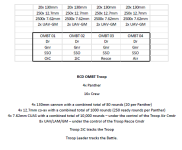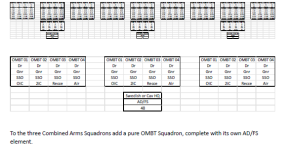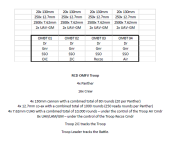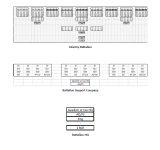I don’t disagree with you that SSE was disappointedly vague.
But I place blame on the CAF for not getting clarifications, or not seeing the vague details as a method to justify preparing for everything and going back to the GOC saying hey that’s a great policy - we need 175k personnel and 85b a year to do it, because we need these things…
Then when the government has a heart attack on the bill, they would either refine the scope of SSE, or hope no one notices a big tax increase.
I'll throw in a few $0.02 on this. I think we need to look back at history especially the disbandment of 4 CMBG and numerous rotos to the former Yugoslavia. As the Century turned the Army (Mike Jeffery in particular) was defining what its role was going to be in an ever shrinking budget envelope. In December of 2002 (with us now committed to Bosnia and just back from a one-of in Afghanistan but with the writing on the wall that we'd be back) Jeffery went before the NDVA committee to explain his problem.
LGen Mike Jeffery: Mr. Chairman, this issue clearly gets at the heart of current capability, which I'm more than willing to address. The scenario surrounding particularly current considerations is obviously a sensitive one, and I will not specifically address that. Let me talk as a force generator responsible for providing overall military capability.
As you are well aware, in terms of my requirements, I need to be able to maintain an immediate reaction unit—basically a light infantry battalion—on 10 days' notice to move; a mechanized battle group on 21 days' notice to move; and up to a full mechanized brigade group on 90 days' notice to move. Achieving all of that has a wide variety of factors around it, and I don't intend to go into those in a great deal of detail unless you wish me to.
Suffice it to say that we certainly can achieve the immediate reaction unit requirements, and indeed we can do that now in terms of that level of capability. A mechanized battle group within 21 days would be a challenge right now, but to go back to the question, it certainly would be easily achievable within six months. ....
In terms of a mechanized brigade group or brigade group requirement, as I've expressed to the committee before, collective training would be a significant factor here, given the fact that we haven't done that kind of training in quite some time. Achieving that within the ninety days would clearly be problematic. Depending on the circumstances, we may very well be able to do it within a six-month timeframe, but a lot of factors would go into play there.
So the problem was fairly clear and new approaches were needed. We went to Kabul, dropped Bosnia and then came back and to Kandahar. Jeffery packed it in the next year and was replaced and Hillier (his Deputy) quickly moved up to CDS, left the Army behind and restructured headquarters and started horse-trading with the government on missions while we implemented managed readiness and whole fleet management to try to meet the needs of both deployed forces and the training requirement back home.
Long story short, problems were not solved, just deferred as we kept cobbling together battle groups, TF headquarters and support elements as we tore apart brigades and Land Force Areas every half year to a year.
One can argue until the cows come home as to whether the Army was abandoning doctrine or rewriting doctrine on a slate blackboard in crayon every year or so to match the current situation. Quite frankly I can't say right now as to whether we have a doctrine or not. We do have TTPs and we still have manuals and we still practice brigade level operations which is a part of that. But IMHO that's a minor part of doctrine.
I tend to be like you. I think doctrine is strategically driven at the government level. It's not just having a battalion establishment and a methodology for using that battalion. Doctrine has cognitive, procedural, organizational, material, and moral components that interact as a whole to create an organization capable of meeting strategic defence objectives.
When Hillier returned from Afghanistan and started his courting ritual with the then Liberal government he worked on the first Defence Policy paper that had been issued in ten years. It was actually synced with the Foreign Affairs one. It's
here. You can clearly see the change in focus to the international failed state intervention concept and the whole host of buzzwords like jointness and relevant and fully integrated etc. There's talk about a standing contingency task force and other mission specific task forces and transformation and new equipment. It's like someone has given you a box of Mechano and told you to go away and build something that will be useful when we need it. The Conservatives' Canada First Defence Policy (
here) of 2013 is no better, just different. Its not until SSE that we see the mission set actually set out in a policy paper rather than internal capability studies and plans. But it aims far below a strategic level and introduces so many irrelevant concepts that one can be excused for wondering what it has to do with defence at all.
I've long been of the view that our biggest defence strategy (or doctrinal) failing is that while we deal with what one could call the department's day-to-day peacetime missions; we have no strategic guidance on the concept of mobilizing for emergencies (including war). We are built to mange low expectations. Meeting peacetime demands is a simple matter of balancing resources to missions. Give us X resources and we produce Y effects. It allows prioritization and even declining or under resourcing of missions because national security is not at risk. What we're missing is a policy of going all-in when the chips are down and it really matters. One gets the feeling that to some governments, national defence, is viewed like a strange hobby that some people need to be involved in rather than a necessity in a dangerous world. I fear that in certain circles the current dust up in the Ukraine will lead to the conclusion that the Russians are not a threat any longer and therefore one can carry on with business as usual.
This is why I keep droning on about a reformed and integrated reserve force and a better way of managing equipment so as to build up a reserve fleet. That is a critical part of doctrine - to create and manage an element of the defence force that is not needed every day but that is available for mobilization (there! I've said the dirty word) when a crisis demands it. Every defence policy, lip service is paid to the reserve force - usually a numbers game of growing the numbers - which is then manipulated internally into producing more pseudo PYs for day to day service (usually administrative) rather than a surge capability.
Quite frankly, I don't think the leadership needs clarification from the government. There is nothing to stop reasonable internal reform so long that it is reasonable. I think the trouble with reasonable reform is that it runs counter to vested interest within both the Reg and ResF (but mostly the RegF and the civil service) The RegF and Civil Service system is entirely too invested in the "rest" component of Neuton's First law of motion. An external force--and a powerful one--is needed to change that.
Rant off














